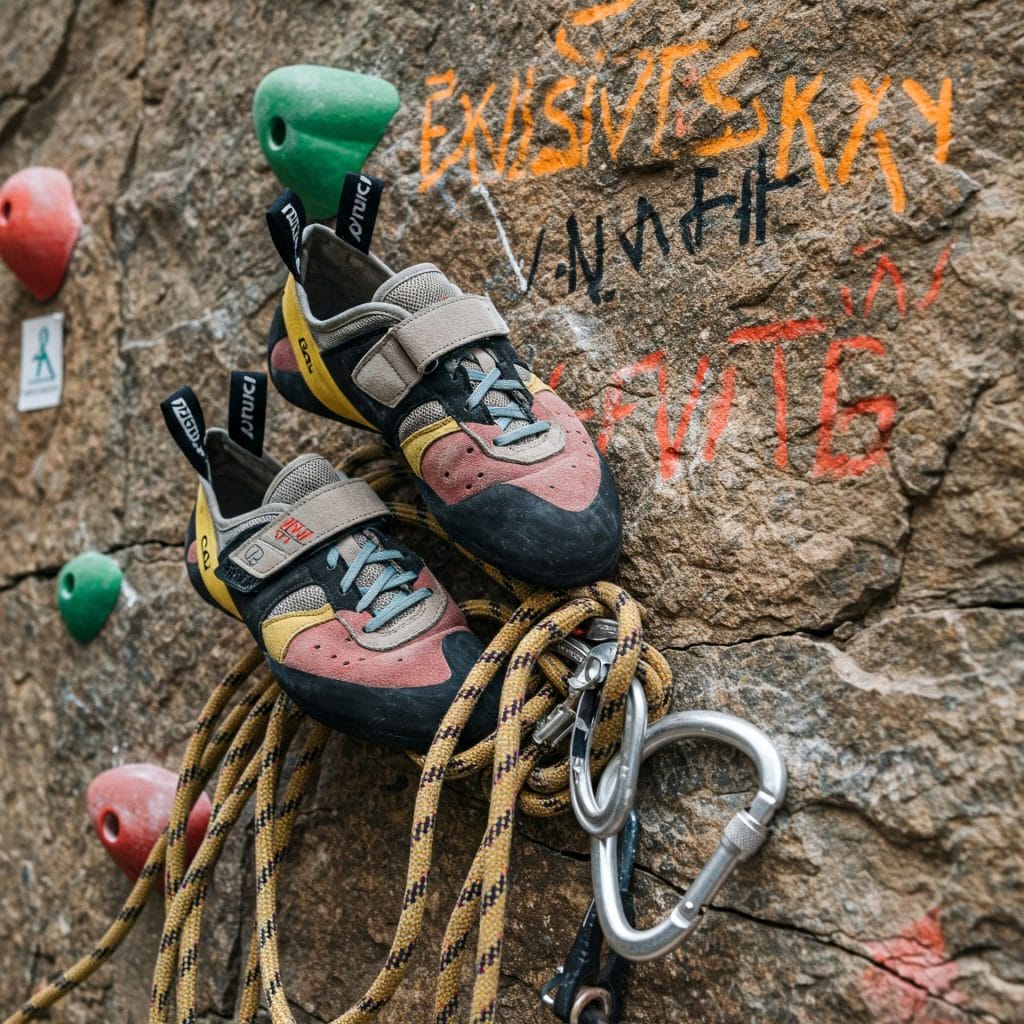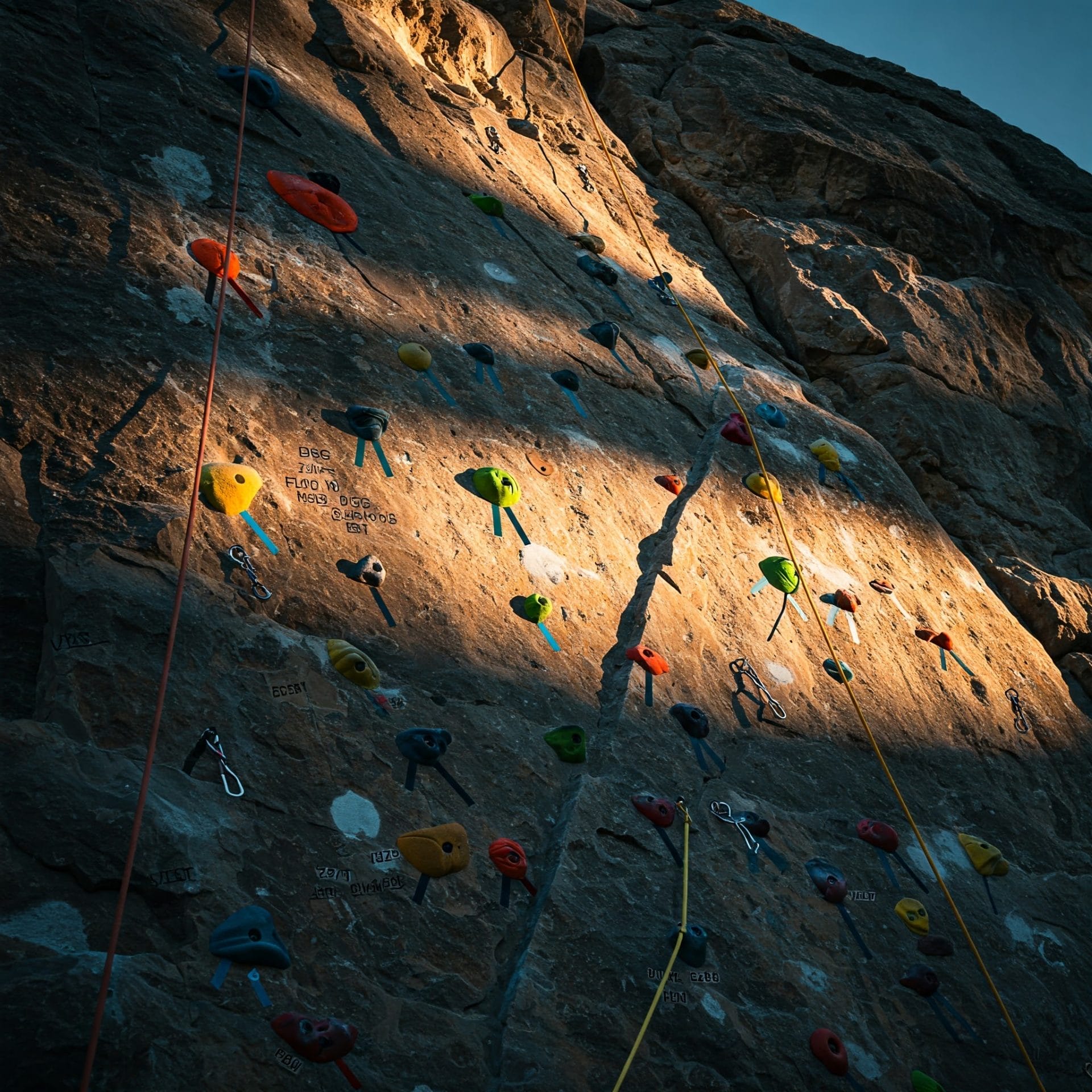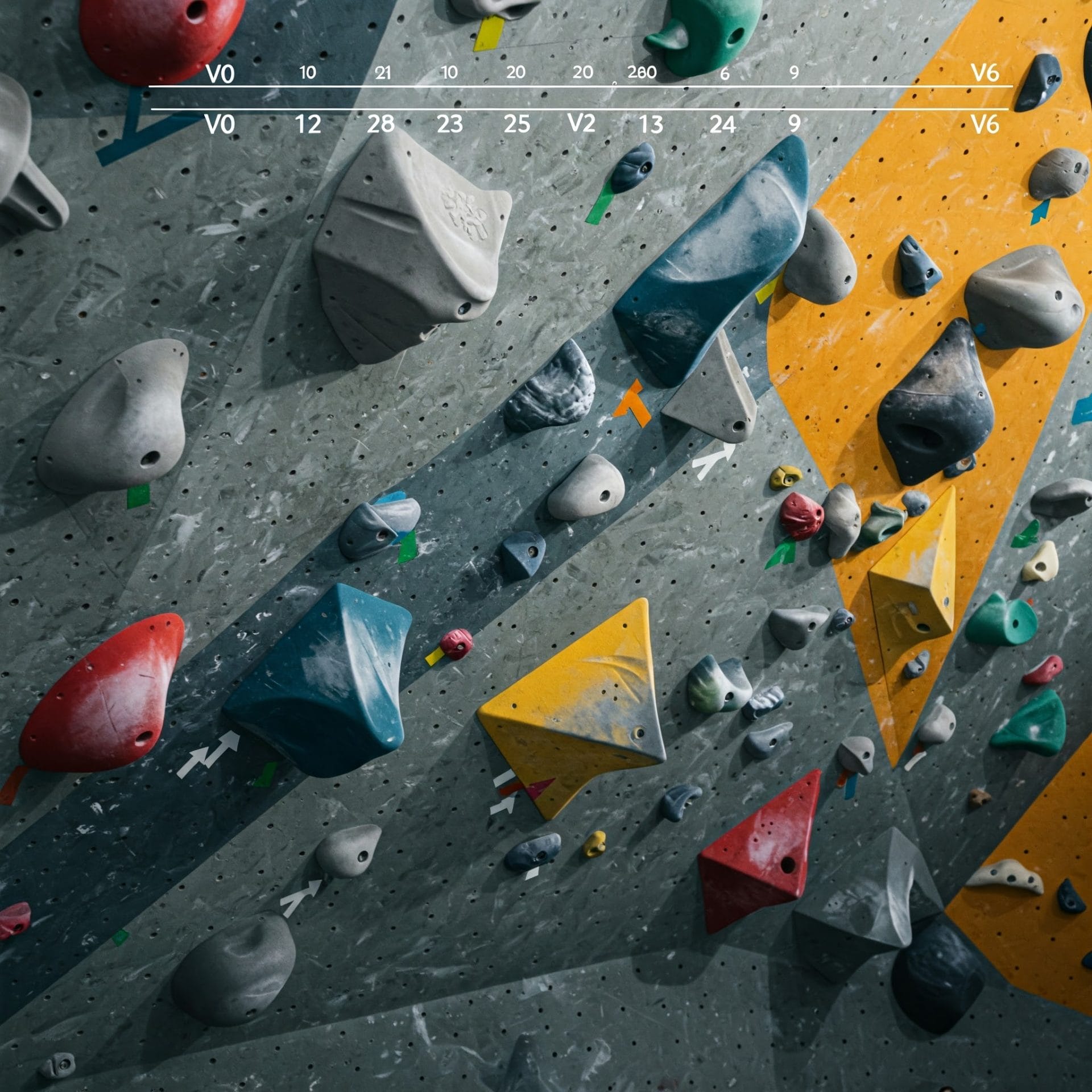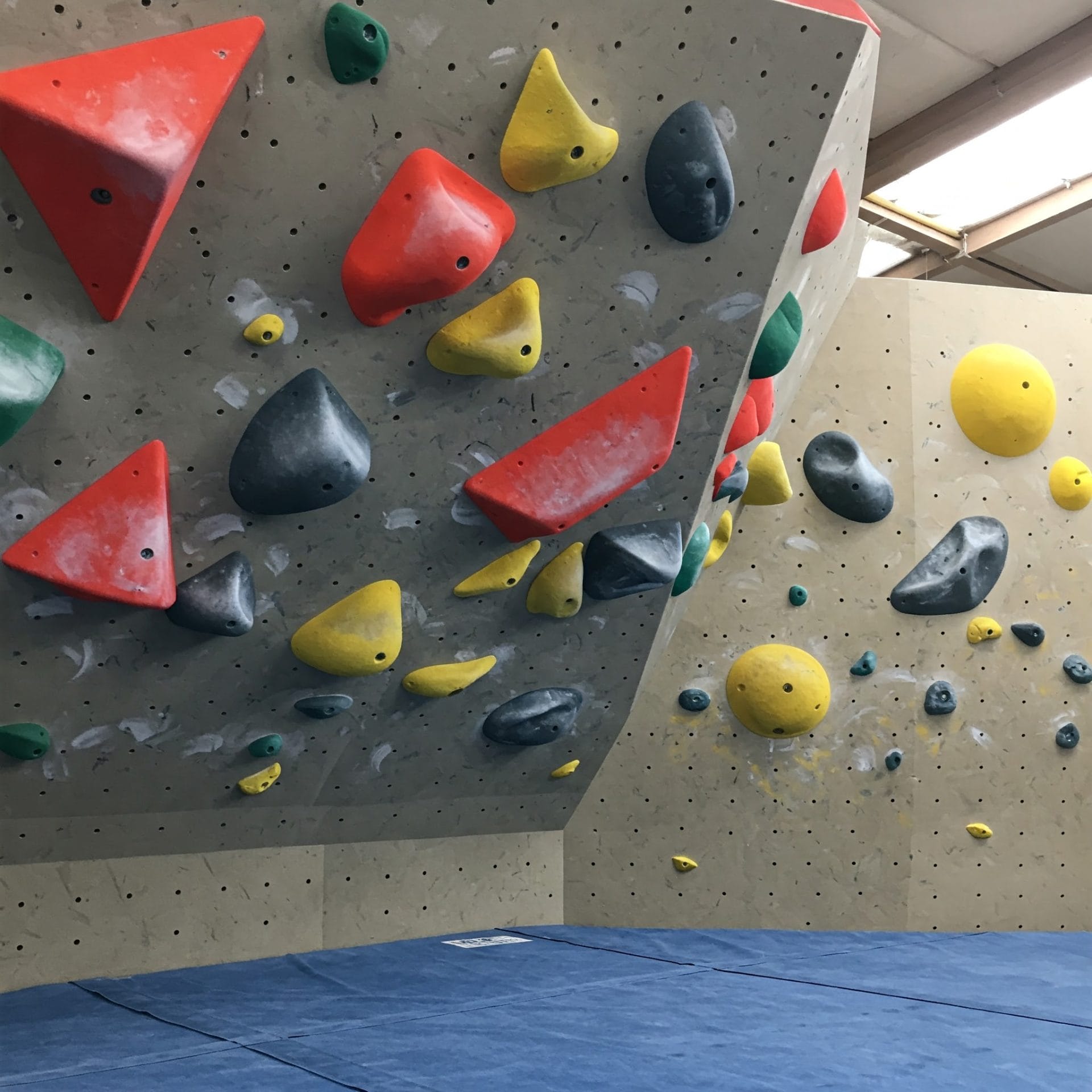Learn the cool terms climbers use to communicate and climb safely. Get ready to impress your friends!
Climbing slang fills gyms and crags with distinctive terms that bind the climbing community together. From safety commands to movement descriptions, these specialized words serve as the backbone of climber communication. A climber yells “take” for rope tension, discusses “beta” for route tips, or celebrates a “send” after completing a tough climb.
Essential terms like “proj” (project routes), “flash” (first-try success), and “crimper” (small finger holds) originated in 1950s American climbing culture. These words aren’t just jargon – they’re vital safety tools, especially when climbers work 40 feet up on challenging routes. Understanding this unique vocabulary opens doors to deeper climbing community connections.(1)
Key Takeaway
- Climbing slang helps climbers communicate about routes and techniques.
- Knowing the terms can improve your climbing skills and safety.
- Climbing slang makes sharing experiences more fun!
What is Climbing Slang?
Climbing isn’t just a physical activity; it’s a culture built on shared experiences and trust. Climbers have their own language, which can be tricky for newcomers. Here are some key terms:
- Beta: Tips or advice to make a climb easier, like which holds to use or when to rest.
- Crux: The hardest part of the climb that requires the most technique or strength.
- Rack: The gear carried on a climber’s harness, such as carabiners, cams, and slings.
- Sending: Successfully completing a route, whether or not you fall.
- Taking a fall: Falling off the wall, which is part of pushing your limits.
Understanding the lingo helps climbers connect and share their experiences. The more you climb, the more natural it feels. Learning the terms helps you belong to the community and can even give you the edge in your climbs.(2)
Common Climbing Terms
Beta: The Unsung Secret to Success
- Beta is climbing advice shared among climbers.
- It can be simple, like suggesting a foot position, or complex, like the best sequence of moves.
- It’s essential for beginners or when trying new routes.
- Experienced climbers often share beta, creating a community of knowledge.
- Beta isn’t universal—what works for one might not work for another.
- Asking for beta makes your climbing experience smoother and builds camaraderie.
Crag: The Heart of Outdoor Climbing
- A crag is an outdoor climbing area with different routes to explore.
- It’s where climbers test their skills, meet others, and enjoy nature.
- Crags can vary in difficulty and beauty.
- Always respect crag rules, including permits or climbing seasons.
Send: The Ultimate Goal
- A send is climbing a route from bottom to top without falling.
- It’s a mix of physical strength and mental focus.
- Sends bring a sense of accomplishment and shared celebration.
Route Features
Climbing is about more than just reaching the top—it’s about each move and decision along the way.
1. Crux: The hardest part of the climb. It tests your physical, mental, and emotional limits. Every crux demands complete focus and determination.
- Physical: Requires strength and endurance.
- Mental: Demands thinking and trusting technique.
- Technical: Involves precision, like tricky holds or off-widths.
2. Run Out: A fear-inducing gap between protection points.
- Short run out: Protection is spaced but safe.
- Long run out: Dangerous due to long gaps.
- Dangerous run out: No protection, requiring extreme precision.
3. Arête: A sharp edge requiring balance, focus, and controlled footwork.
- Keep your center of gravity steady.
- Mental strength is as important as physical strength.
4. Chimney: A narrow vertical gap.
- Squeeze your body for leverage.
- Use body tension to inch upward.
Types of Holds
1. Jug/Bucket: These large, supportive holds are great for resting. They provide a lot of surface area, allowing you to spread out your fingers and take a break. You can grip them fully, and they give you a moment to reset for tougher moves.
- Size: Usually 3 inches or more.
- Grip: Full hand grip.
- Feeling: Relaxing, allows recovery.
2. Crimp: Small, tough holds that require precise finger positioning. You’ll feel constant pressure as you grip them with just your fingertips. Over time, the technique becomes second nature.
- Size: No wider than 2 inches.
- Grip: Fingers curl to create a pinching effect.
- Feeling: Tense and demanding.
3. Pocket: Shaped holes for fingers, testing your grip and balance. The size can vary, but they challenge your ability to use just a few fingers effectively.
- Size: Half an inch to a few inches.
- Grip: One or more fingers.
- Feeling: Awkward at first, satisfying once mastered.
4. Mono: A small hole that fits only one finger, requiring strength and technique to hold your weight.
- Size: Just enough for one finger.
- Grip: One finger, relying on thumb for stability.
- Feeling: Challenging but rewarding.
Climbing Techniques
Credit:By Catalyst Climbing
Climbing is more than just muscle and grit. It’s about technique, and mastering moves like the Gaston, rock-over, and jam can save energy and improve your performance.
- Gaston: Involves pushing with your palm facing outward. It requires stability and body positioning, leaning away from the wall. Legs play a crucial role in maintaining balance.
- Rock-over: Focuses on shifting weight over a high foot. It’s about finding the right balance—your foot must be high enough to support you but not too high to strain muscles.
- Jam: Involves wedging hands or feet into a crack for stability. While uncomfortable, it uses the rock itself to hold you in place, saving energy on long climbs.
The key to success with these moves is practice. Focus on technique, take your time, and work with the rock instead of against it.
Climbing Gear Terms

- Bolts:
- A bolt is a metal anchor drilled into the rock face, crucial for climbing safety.
- Made of steel or titanium, bolts withstand pressure from falls and climbing forces.
- Sport climbing uses expansion bolts, which spread inside a hole to secure themselves.
- In trad climbing, bolts are less common; climbers use gear like cams or nuts.
- Bolts are essential for routes without natural features.
- When clipped into a bolt, climbers feel safer, knowing it will hold in case of a fall.
- Clipping:
- Clipping is attaching the rope to a quickdraw, which connects the rope and bolt.
- Proper clipping prevents rope damage and ensures a solid connection.
- It can be tricky, especially when reaching above your head or hanging.
- Mastering clipping brings confidence and smooth climbing rhythm.
- Chockstone:
- A chockstone is a rock wedged in a crack, offering natural stability.
- It can support weight but may be unstable.
- Always check a chockstone before using it for support.
Types of Climbing
Sport Climbing: The Joy of Fixed Protection
Sport climbing is about finding rhythm on the rock. With fixed bolts spaced along the route, safety is assured. Key elements include:
- Bolts and Quickdraws: Fixed protections; bolts are drilled, quickdraws clip into them.
- Rope: Your safety lifeline, crucial for fall protection.
- Climbing Shoes: Essential for grip.
- Chalk: Keeps hands dry for a secure hold.
Sport climbing is more accessible, as you don’t focus on gear placement. The challenge is personal your body must rise to the occasion.
Trad Climbing: A Dance with the Rock
Trad climbing requires placing your own protection, creating a deeper connection with the rock. Key elements:
- Nuts and Cams: Fit into cracks for protection.
- Rope: Your safety line.
- Harness & Belay Device: Essential for security and control.
It’s mentally demanding and requires trust in your experience.
Aid Climbing: When the Gear Does the Work
Aid climbing involves using gear to assist your ascent, rather than relying on strength. Key elements:
- Gear-Assisted Movement: Uses tools like etriers and cam hooks.
- Rope: Provides safety and movement assistance.
Aid climbing focuses on technicality and patience, step by step.
Practical Tips for Using Climbing Slang
When you’re hanging from a cliff, frustration might set in. You’re tired, your hands are sweating, and you’re wondering how to keep going. But here’s the thing—every climber has been there. Asking for beta is one of the best things you can do.
- Beta from someone who’s climbed the route can save time and energy.
- You’ll hear things like, “Take that hold with your right hand, step with your left foot.”
- It’s not cheating; it’s climbing smart.
Sometimes, you won’t have others to rely on, and that’s where practice comes in.
- Work on technique like the rock-over, which helps climbing feel less like a fight.
- Practice your jams, and soon they’ll feel natural.
To level up, explore different crags.
- Every crag has its own challenges and teaches new moves.
- Climbing in new areas makes you more versatile and skilled.
Ask for beta, practice your moves, and try new crags for faster improvement.
Conclusion
Climbing slang serves as a critical communication tool in the climbing community. These specialized terms (like beta, dyno, and crimp) help climbers describe routes and movements with precision. The language goes beyond mere jargon – it creates clear safety protocols and builds shared understanding among climbers. Knowledge of these terms enhances climbing performance and facilitates better communication at the crag, making it an essential part of the sport.
FAQ
What is climbing slang?
Climbing slang refers to the unique words and phrases used by climbers to communicate more easily and efficiently. This slang often comes from the climbing community and helps climbers describe techniques, equipment, and experiences. It’s a way for climbers to bond over shared language and enhance their understanding of the sport.
Why do climbers use slang?
Climbers use slang to create a sense of community and to simplify communication. The climbing world has many technical terms that can be shortened or made more relatable through slang. This makes it easier for climbers to share experiences, give advice, and connect with each other, especially in challenging situations.
What are some common climbing slang terms?
Some common climbing slang terms include “beta,” which refers to advice or information about a climb, and “crux,” the hardest part of a route. Other terms include “send,” meaning to complete a climb successfully, and “screamer,” which describes a fall that involves a lot of slack in the rope.
How does climbing slang evolve?
Climbing slang evolves as new techniques, gear, and trends emerge in the climbing community. As climbers innovate and share their experiences, new terms are adopted, while older ones may fade away. This keeps the language fresh and relevant, helping climbers stay connected through their shared experiences.
Is climbing slang only used by experienced climbers?
While climbing slang is often more familiar to experienced climbers, beginners can learn these terms quickly. Many climbers enjoy sharing their knowledge and helping newcomers understand the slang. As beginners gain experience, they’ll likely pick up the language naturally through conversations and climbing events.
Are there regional differences in climbing slang?
Yes, climbing slang can vary by region. Different climbing areas might have their own unique terms or variations of common slang. This regional aspect adds richness to the language and reflects the diverse climbing culture across the globe, making it interesting for climbers to learn about.
How can I learn climbing slang?
You can learn climbing slang by spending time with other climbers, joining climbing classes, or attending climbing events. Online climbing forums and social media groups are also great resources to see how slang is used in context. The more you climb and interact with the climbing community, the more familiar you’ll become with the language.
Why is it important to understand climbing slang?
Understanding climbing slang helps you communicate effectively with other climbers and enhances your climbing experience. It can make discussions about routes and techniques easier, and it helps you feel more connected to the community. Plus, knowing the slang can make climbing feel more fun and engaging.
References
- https://weareexplorers.co/word-beta-rock-climbing-slang/
- https://www.reddit.com/r/climbergirls/comments/r4hdam/climbing_slang_help_me_make_sense_of_it/






